Facility and Risk Management Report: Doltone House, MNG01222
VerifiedAdded on 2022/09/14
|8
|2171
|16
Report
AI Summary
This report presents a comprehensive analysis of facility and risk management practices at The Doltone House, specifically focusing on its branch at Jones Bay Wharf. The report delves into the venue's design, exploring its relevance, intended purpose, and adherence to design principles such as transportation, comfort, and hygiene. It examines stakeholder objectives, including customer and investor satisfaction, and assesses the venue's condition, employing theories of change and performance to evaluate its operations. The report highlights the challenges faced in applying these theories, such as identifying the most critical areas for change and understanding the causes of performance fluctuations. Furthermore, the report provides insights into the venue's safety considerations and its impact on the overall business success. The assessment includes an executive summary, table of contents, introduction, venue design analysis, venue condition assessment, conclusion, references, and relevant figures like floor plans and venue condition assessment forms. The report is a case study of the venue's approach to facility and risk management.
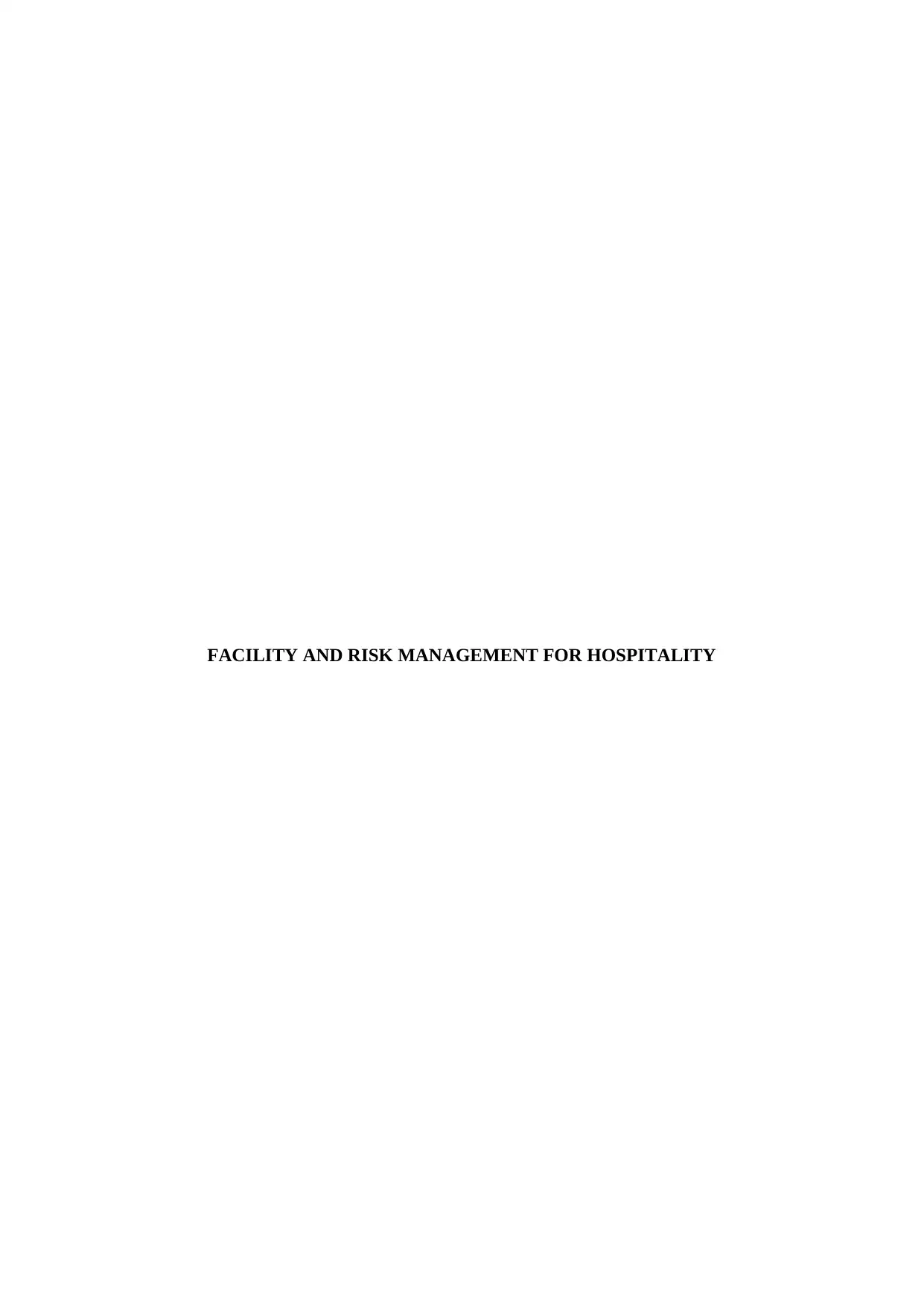
FACILITY AND RISK MANAGEMENT FOR HOSPITALITY
Paraphrase This Document
Need a fresh take? Get an instant paraphrase of this document with our AI Paraphraser
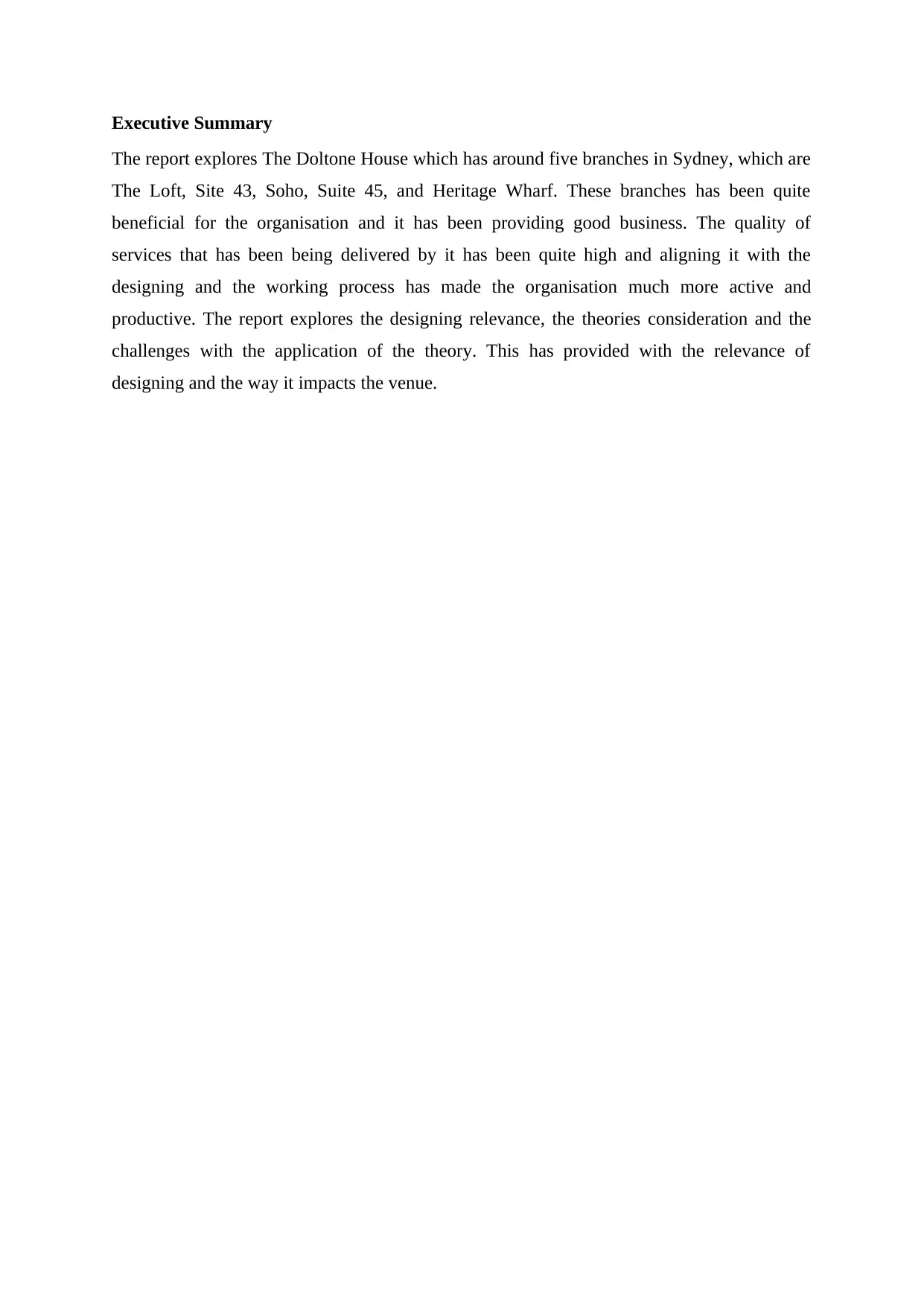
Executive Summary
The report explores The Doltone House which has around five branches in Sydney, which are
The Loft, Site 43, Soho, Suite 45, and Heritage Wharf. These branches has been quite
beneficial for the organisation and it has been providing good business. The quality of
services that has been being delivered by it has been quite high and aligning it with the
designing and the working process has made the organisation much more active and
productive. The report explores the designing relevance, the theories consideration and the
challenges with the application of the theory. This has provided with the relevance of
designing and the way it impacts the venue.
The report explores The Doltone House which has around five branches in Sydney, which are
The Loft, Site 43, Soho, Suite 45, and Heritage Wharf. These branches has been quite
beneficial for the organisation and it has been providing good business. The quality of
services that has been being delivered by it has been quite high and aligning it with the
designing and the working process has made the organisation much more active and
productive. The report explores the designing relevance, the theories consideration and the
challenges with the application of the theory. This has provided with the relevance of
designing and the way it impacts the venue.
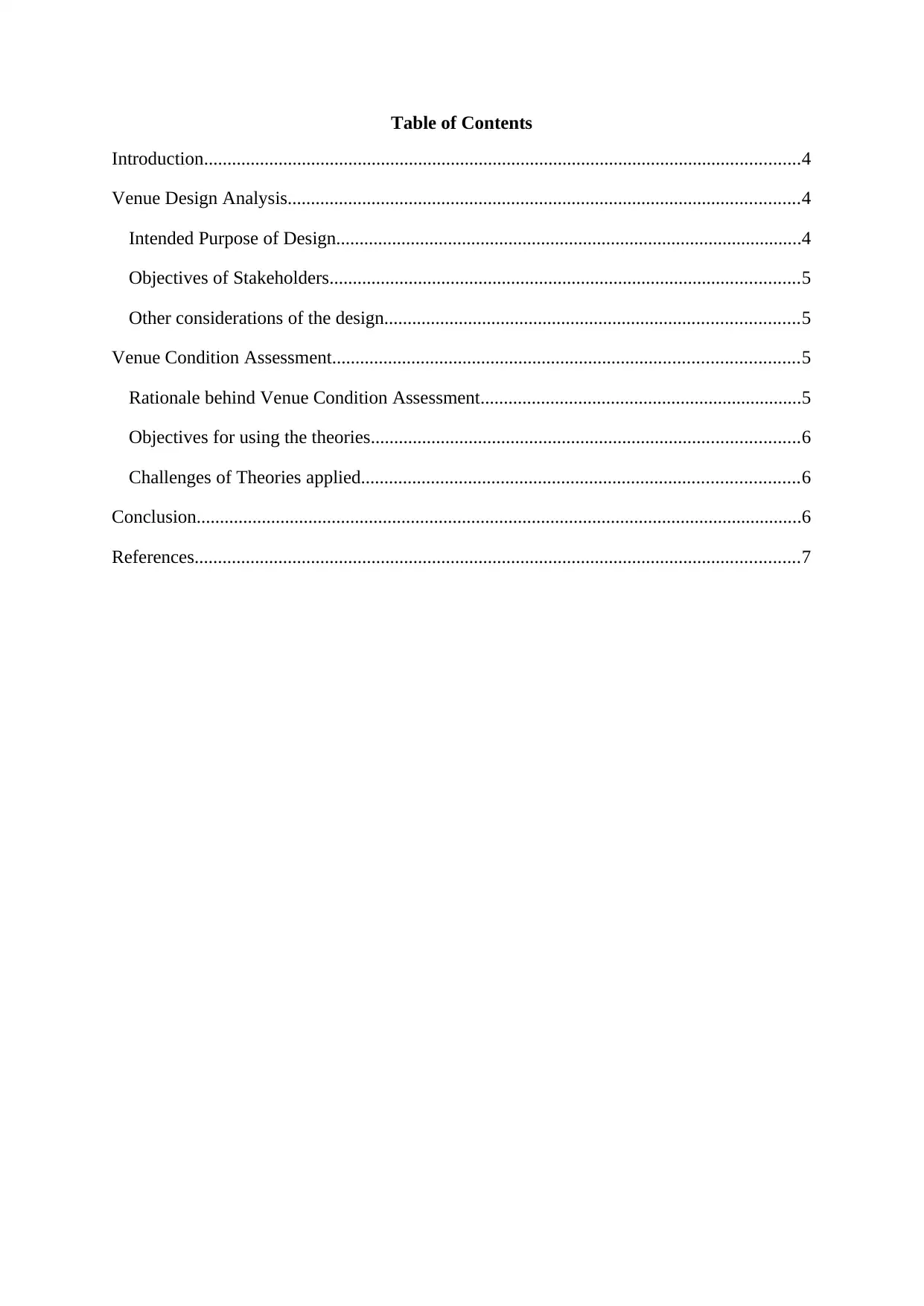
Table of Contents
Introduction................................................................................................................................4
Venue Design Analysis..............................................................................................................4
Intended Purpose of Design....................................................................................................4
Objectives of Stakeholders.....................................................................................................5
Other considerations of the design.........................................................................................5
Venue Condition Assessment....................................................................................................5
Rationale behind Venue Condition Assessment.....................................................................5
Objectives for using the theories............................................................................................6
Challenges of Theories applied..............................................................................................6
Conclusion..................................................................................................................................6
References..................................................................................................................................7
Introduction................................................................................................................................4
Venue Design Analysis..............................................................................................................4
Intended Purpose of Design....................................................................................................4
Objectives of Stakeholders.....................................................................................................5
Other considerations of the design.........................................................................................5
Venue Condition Assessment....................................................................................................5
Rationale behind Venue Condition Assessment.....................................................................5
Objectives for using the theories............................................................................................6
Challenges of Theories applied..............................................................................................6
Conclusion..................................................................................................................................6
References..................................................................................................................................7
⊘ This is a preview!⊘
Do you want full access?
Subscribe today to unlock all pages.

Trusted by 1+ million students worldwide
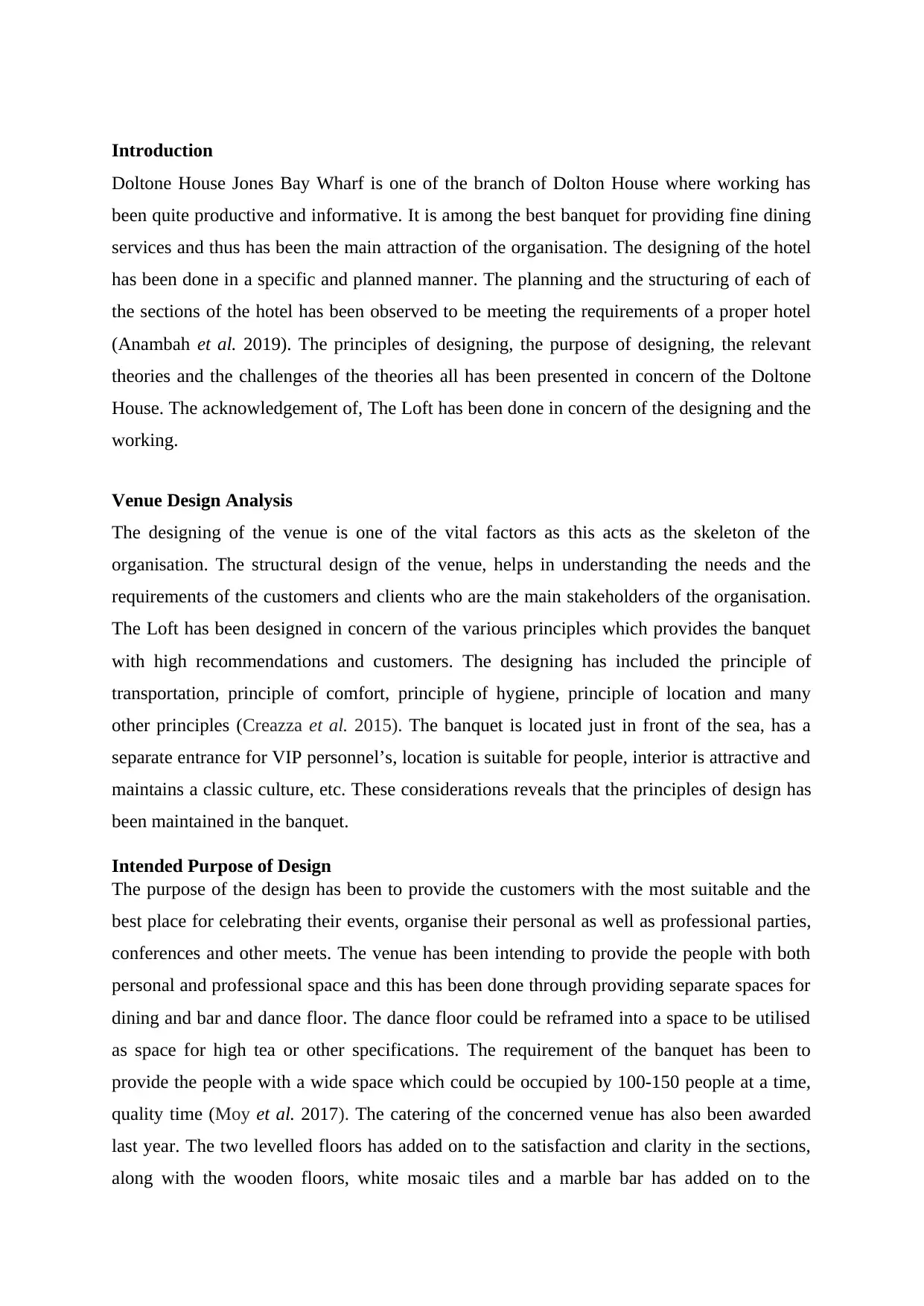
Introduction
Doltone House Jones Bay Wharf is one of the branch of Dolton House where working has
been quite productive and informative. It is among the best banquet for providing fine dining
services and thus has been the main attraction of the organisation. The designing of the hotel
has been done in a specific and planned manner. The planning and the structuring of each of
the sections of the hotel has been observed to be meeting the requirements of a proper hotel
(Anambah et al. 2019). The principles of designing, the purpose of designing, the relevant
theories and the challenges of the theories all has been presented in concern of the Doltone
House. The acknowledgement of, The Loft has been done in concern of the designing and the
working.
Venue Design Analysis
The designing of the venue is one of the vital factors as this acts as the skeleton of the
organisation. The structural design of the venue, helps in understanding the needs and the
requirements of the customers and clients who are the main stakeholders of the organisation.
The Loft has been designed in concern of the various principles which provides the banquet
with high recommendations and customers. The designing has included the principle of
transportation, principle of comfort, principle of hygiene, principle of location and many
other principles (Creazza et al. 2015). The banquet is located just in front of the sea, has a
separate entrance for VIP personnel’s, location is suitable for people, interior is attractive and
maintains a classic culture, etc. These considerations reveals that the principles of design has
been maintained in the banquet.
Intended Purpose of Design
The purpose of the design has been to provide the customers with the most suitable and the
best place for celebrating their events, organise their personal as well as professional parties,
conferences and other meets. The venue has been intending to provide the people with both
personal and professional space and this has been done through providing separate spaces for
dining and bar and dance floor. The dance floor could be reframed into a space to be utilised
as space for high tea or other specifications. The requirement of the banquet has been to
provide the people with a wide space which could be occupied by 100-150 people at a time,
quality time (Moy et al. 2017). The catering of the concerned venue has also been awarded
last year. The two levelled floors has added on to the satisfaction and clarity in the sections,
along with the wooden floors, white mosaic tiles and a marble bar has added on to the
Doltone House Jones Bay Wharf is one of the branch of Dolton House where working has
been quite productive and informative. It is among the best banquet for providing fine dining
services and thus has been the main attraction of the organisation. The designing of the hotel
has been done in a specific and planned manner. The planning and the structuring of each of
the sections of the hotel has been observed to be meeting the requirements of a proper hotel
(Anambah et al. 2019). The principles of designing, the purpose of designing, the relevant
theories and the challenges of the theories all has been presented in concern of the Doltone
House. The acknowledgement of, The Loft has been done in concern of the designing and the
working.
Venue Design Analysis
The designing of the venue is one of the vital factors as this acts as the skeleton of the
organisation. The structural design of the venue, helps in understanding the needs and the
requirements of the customers and clients who are the main stakeholders of the organisation.
The Loft has been designed in concern of the various principles which provides the banquet
with high recommendations and customers. The designing has included the principle of
transportation, principle of comfort, principle of hygiene, principle of location and many
other principles (Creazza et al. 2015). The banquet is located just in front of the sea, has a
separate entrance for VIP personnel’s, location is suitable for people, interior is attractive and
maintains a classic culture, etc. These considerations reveals that the principles of design has
been maintained in the banquet.
Intended Purpose of Design
The purpose of the design has been to provide the customers with the most suitable and the
best place for celebrating their events, organise their personal as well as professional parties,
conferences and other meets. The venue has been intending to provide the people with both
personal and professional space and this has been done through providing separate spaces for
dining and bar and dance floor. The dance floor could be reframed into a space to be utilised
as space for high tea or other specifications. The requirement of the banquet has been to
provide the people with a wide space which could be occupied by 100-150 people at a time,
quality time (Moy et al. 2017). The catering of the concerned venue has also been awarded
last year. The two levelled floors has added on to the satisfaction and clarity in the sections,
along with the wooden floors, white mosaic tiles and a marble bar has added on to the
Paraphrase This Document
Need a fresh take? Get an instant paraphrase of this document with our AI Paraphraser
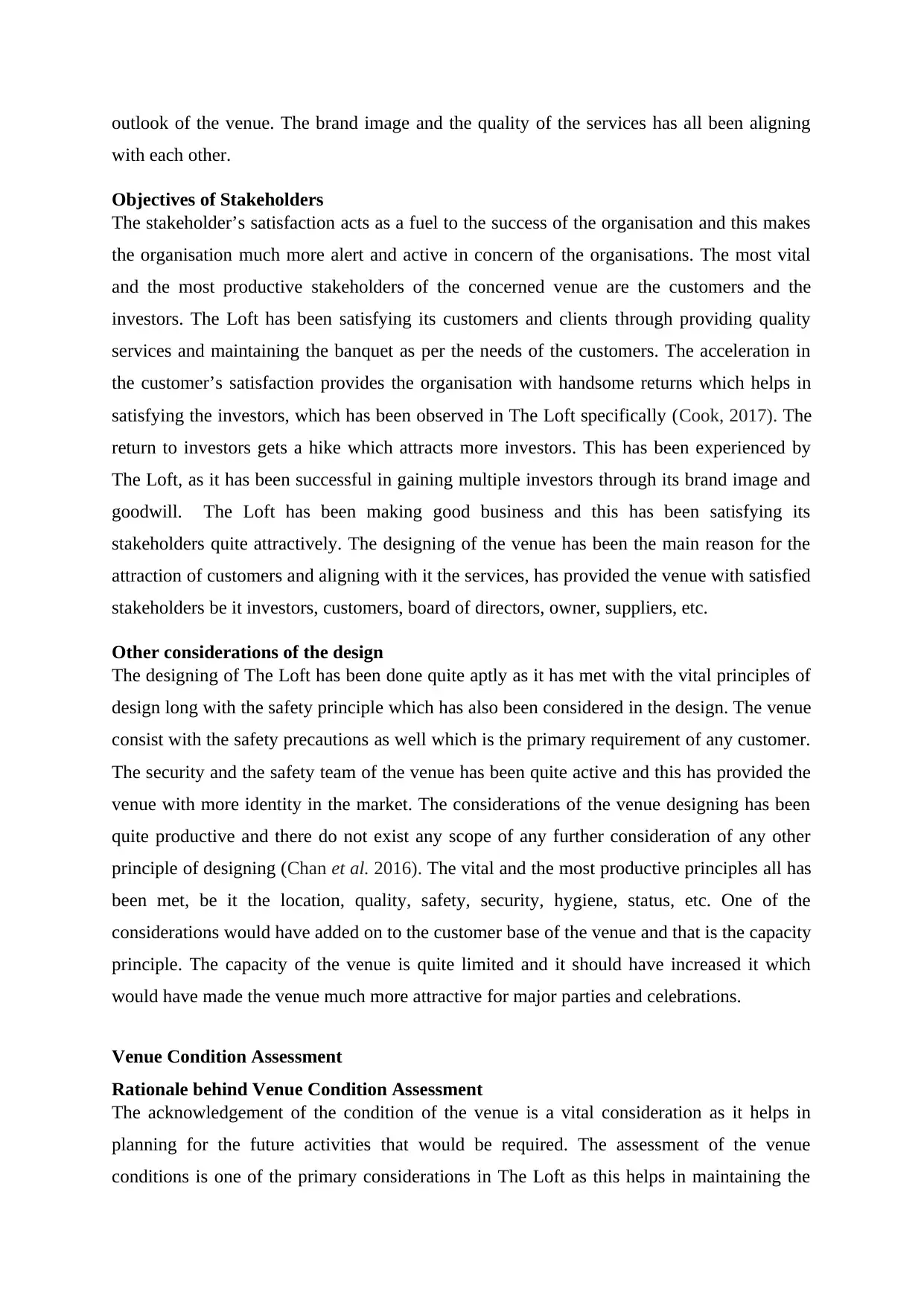
outlook of the venue. The brand image and the quality of the services has all been aligning
with each other.
Objectives of Stakeholders
The stakeholder’s satisfaction acts as a fuel to the success of the organisation and this makes
the organisation much more alert and active in concern of the organisations. The most vital
and the most productive stakeholders of the concerned venue are the customers and the
investors. The Loft has been satisfying its customers and clients through providing quality
services and maintaining the banquet as per the needs of the customers. The acceleration in
the customer’s satisfaction provides the organisation with handsome returns which helps in
satisfying the investors, which has been observed in The Loft specifically (Cook, 2017). The
return to investors gets a hike which attracts more investors. This has been experienced by
The Loft, as it has been successful in gaining multiple investors through its brand image and
goodwill. The Loft has been making good business and this has been satisfying its
stakeholders quite attractively. The designing of the venue has been the main reason for the
attraction of customers and aligning with it the services, has provided the venue with satisfied
stakeholders be it investors, customers, board of directors, owner, suppliers, etc.
Other considerations of the design
The designing of The Loft has been done quite aptly as it has met with the vital principles of
design long with the safety principle which has also been considered in the design. The venue
consist with the safety precautions as well which is the primary requirement of any customer.
The security and the safety team of the venue has been quite active and this has provided the
venue with more identity in the market. The considerations of the venue designing has been
quite productive and there do not exist any scope of any further consideration of any other
principle of designing (Chan et al. 2016). The vital and the most productive principles all has
been met, be it the location, quality, safety, security, hygiene, status, etc. One of the
considerations would have added on to the customer base of the venue and that is the capacity
principle. The capacity of the venue is quite limited and it should have increased it which
would have made the venue much more attractive for major parties and celebrations.
Venue Condition Assessment
Rationale behind Venue Condition Assessment
The acknowledgement of the condition of the venue is a vital consideration as it helps in
planning for the future activities that would be required. The assessment of the venue
conditions is one of the primary considerations in The Loft as this helps in maintaining the
with each other.
Objectives of Stakeholders
The stakeholder’s satisfaction acts as a fuel to the success of the organisation and this makes
the organisation much more alert and active in concern of the organisations. The most vital
and the most productive stakeholders of the concerned venue are the customers and the
investors. The Loft has been satisfying its customers and clients through providing quality
services and maintaining the banquet as per the needs of the customers. The acceleration in
the customer’s satisfaction provides the organisation with handsome returns which helps in
satisfying the investors, which has been observed in The Loft specifically (Cook, 2017). The
return to investors gets a hike which attracts more investors. This has been experienced by
The Loft, as it has been successful in gaining multiple investors through its brand image and
goodwill. The Loft has been making good business and this has been satisfying its
stakeholders quite attractively. The designing of the venue has been the main reason for the
attraction of customers and aligning with it the services, has provided the venue with satisfied
stakeholders be it investors, customers, board of directors, owner, suppliers, etc.
Other considerations of the design
The designing of The Loft has been done quite aptly as it has met with the vital principles of
design long with the safety principle which has also been considered in the design. The venue
consist with the safety precautions as well which is the primary requirement of any customer.
The security and the safety team of the venue has been quite active and this has provided the
venue with more identity in the market. The considerations of the venue designing has been
quite productive and there do not exist any scope of any further consideration of any other
principle of designing (Chan et al. 2016). The vital and the most productive principles all has
been met, be it the location, quality, safety, security, hygiene, status, etc. One of the
considerations would have added on to the customer base of the venue and that is the capacity
principle. The capacity of the venue is quite limited and it should have increased it which
would have made the venue much more attractive for major parties and celebrations.
Venue Condition Assessment
Rationale behind Venue Condition Assessment
The acknowledgement of the condition of the venue is a vital consideration as it helps in
planning for the future activities that would be required. The assessment of the venue
conditions is one of the primary considerations in The Loft as this helps in maintaining the
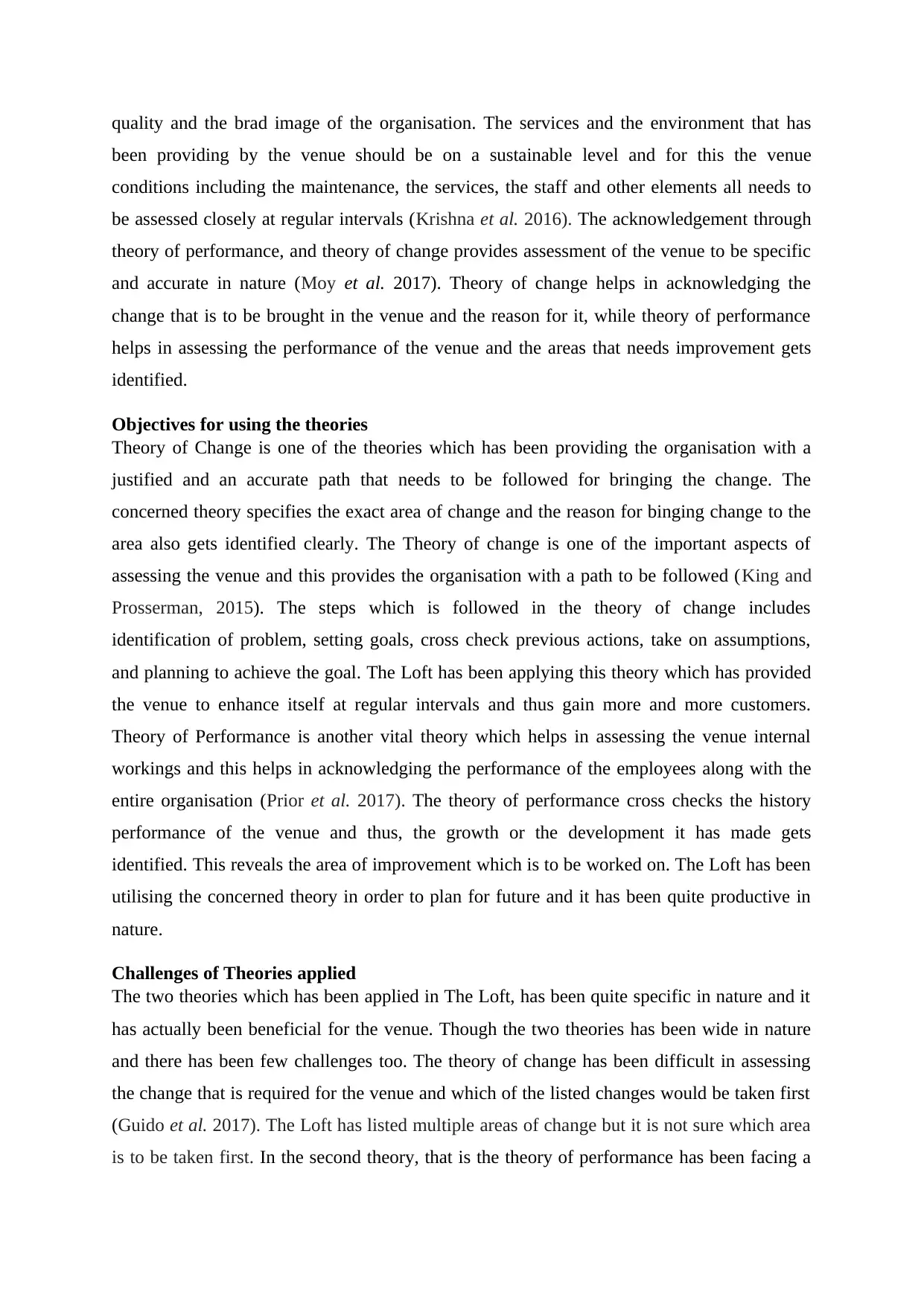
quality and the brad image of the organisation. The services and the environment that has
been providing by the venue should be on a sustainable level and for this the venue
conditions including the maintenance, the services, the staff and other elements all needs to
be assessed closely at regular intervals (Krishna et al. 2016). The acknowledgement through
theory of performance, and theory of change provides assessment of the venue to be specific
and accurate in nature (Moy et al. 2017). Theory of change helps in acknowledging the
change that is to be brought in the venue and the reason for it, while theory of performance
helps in assessing the performance of the venue and the areas that needs improvement gets
identified.
Objectives for using the theories
Theory of Change is one of the theories which has been providing the organisation with a
justified and an accurate path that needs to be followed for bringing the change. The
concerned theory specifies the exact area of change and the reason for binging change to the
area also gets identified clearly. The Theory of change is one of the important aspects of
assessing the venue and this provides the organisation with a path to be followed (King and
Prosserman, 2015). The steps which is followed in the theory of change includes
identification of problem, setting goals, cross check previous actions, take on assumptions,
and planning to achieve the goal. The Loft has been applying this theory which has provided
the venue to enhance itself at regular intervals and thus gain more and more customers.
Theory of Performance is another vital theory which helps in assessing the venue internal
workings and this helps in acknowledging the performance of the employees along with the
entire organisation (Prior et al. 2017). The theory of performance cross checks the history
performance of the venue and thus, the growth or the development it has made gets
identified. This reveals the area of improvement which is to be worked on. The Loft has been
utilising the concerned theory in order to plan for future and it has been quite productive in
nature.
Challenges of Theories applied
The two theories which has been applied in The Loft, has been quite specific in nature and it
has actually been beneficial for the venue. Though the two theories has been wide in nature
and there has been few challenges too. The theory of change has been difficult in assessing
the change that is required for the venue and which of the listed changes would be taken first
(Guido et al. 2017). The Loft has listed multiple areas of change but it is not sure which area
is to be taken first. In the second theory, that is the theory of performance has been facing a
been providing by the venue should be on a sustainable level and for this the venue
conditions including the maintenance, the services, the staff and other elements all needs to
be assessed closely at regular intervals (Krishna et al. 2016). The acknowledgement through
theory of performance, and theory of change provides assessment of the venue to be specific
and accurate in nature (Moy et al. 2017). Theory of change helps in acknowledging the
change that is to be brought in the venue and the reason for it, while theory of performance
helps in assessing the performance of the venue and the areas that needs improvement gets
identified.
Objectives for using the theories
Theory of Change is one of the theories which has been providing the organisation with a
justified and an accurate path that needs to be followed for bringing the change. The
concerned theory specifies the exact area of change and the reason for binging change to the
area also gets identified clearly. The Theory of change is one of the important aspects of
assessing the venue and this provides the organisation with a path to be followed (King and
Prosserman, 2015). The steps which is followed in the theory of change includes
identification of problem, setting goals, cross check previous actions, take on assumptions,
and planning to achieve the goal. The Loft has been applying this theory which has provided
the venue to enhance itself at regular intervals and thus gain more and more customers.
Theory of Performance is another vital theory which helps in assessing the venue internal
workings and this helps in acknowledging the performance of the employees along with the
entire organisation (Prior et al. 2017). The theory of performance cross checks the history
performance of the venue and thus, the growth or the development it has made gets
identified. This reveals the area of improvement which is to be worked on. The Loft has been
utilising the concerned theory in order to plan for future and it has been quite productive in
nature.
Challenges of Theories applied
The two theories which has been applied in The Loft, has been quite specific in nature and it
has actually been beneficial for the venue. Though the two theories has been wide in nature
and there has been few challenges too. The theory of change has been difficult in assessing
the change that is required for the venue and which of the listed changes would be taken first
(Guido et al. 2017). The Loft has listed multiple areas of change but it is not sure which area
is to be taken first. In the second theory, that is the theory of performance has been facing a
⊘ This is a preview!⊘
Do you want full access?
Subscribe today to unlock all pages.

Trusted by 1+ million students worldwide
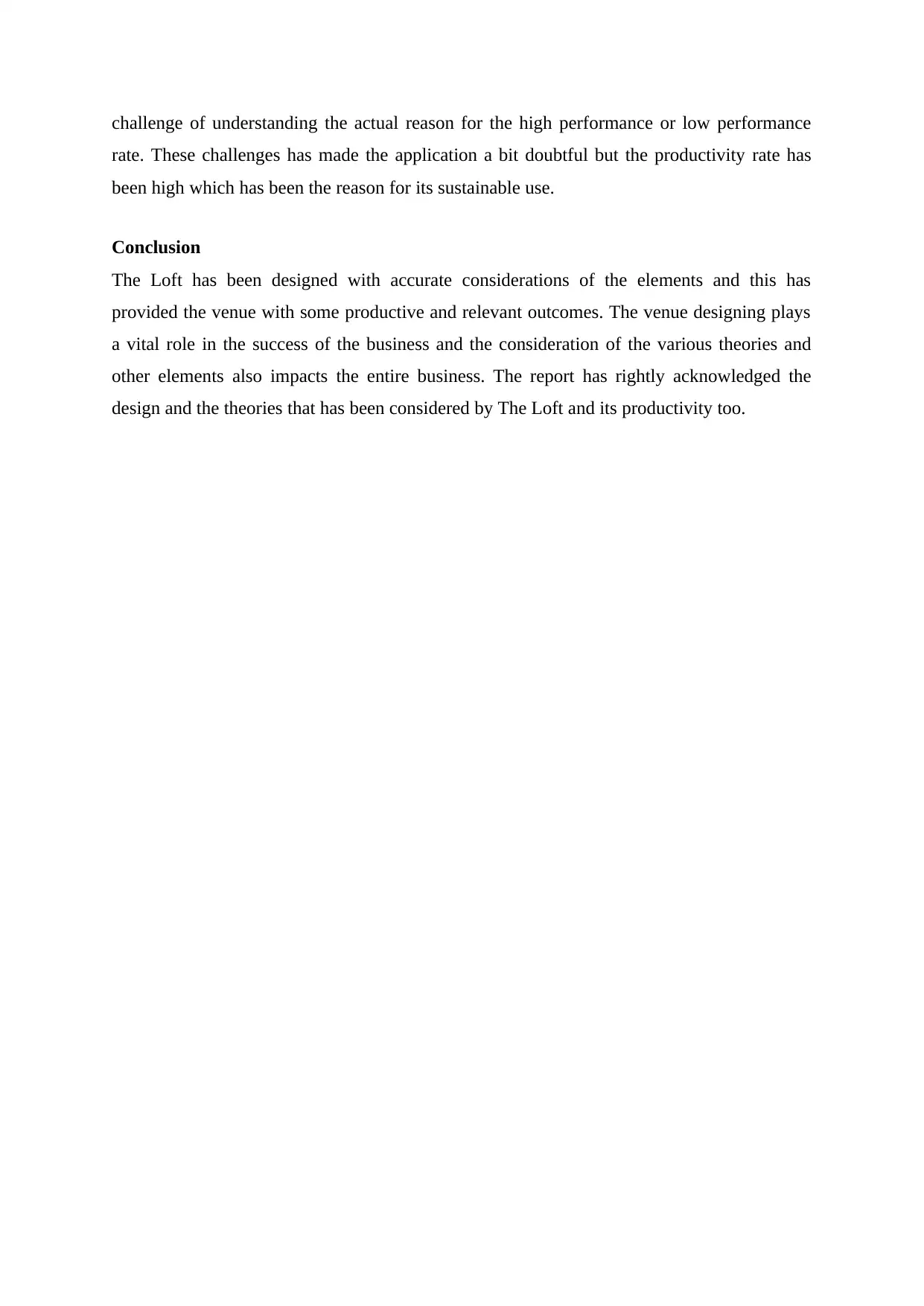
challenge of understanding the actual reason for the high performance or low performance
rate. These challenges has made the application a bit doubtful but the productivity rate has
been high which has been the reason for its sustainable use.
Conclusion
The Loft has been designed with accurate considerations of the elements and this has
provided the venue with some productive and relevant outcomes. The venue designing plays
a vital role in the success of the business and the consideration of the various theories and
other elements also impacts the entire business. The report has rightly acknowledged the
design and the theories that has been considered by The Loft and its productivity too.
rate. These challenges has made the application a bit doubtful but the productivity rate has
been high which has been the reason for its sustainable use.
Conclusion
The Loft has been designed with accurate considerations of the elements and this has
provided the venue with some productive and relevant outcomes. The venue designing plays
a vital role in the success of the business and the consideration of the various theories and
other elements also impacts the entire business. The report has rightly acknowledged the
design and the theories that has been considered by The Loft and its productivity too.
Paraphrase This Document
Need a fresh take? Get an instant paraphrase of this document with our AI Paraphraser
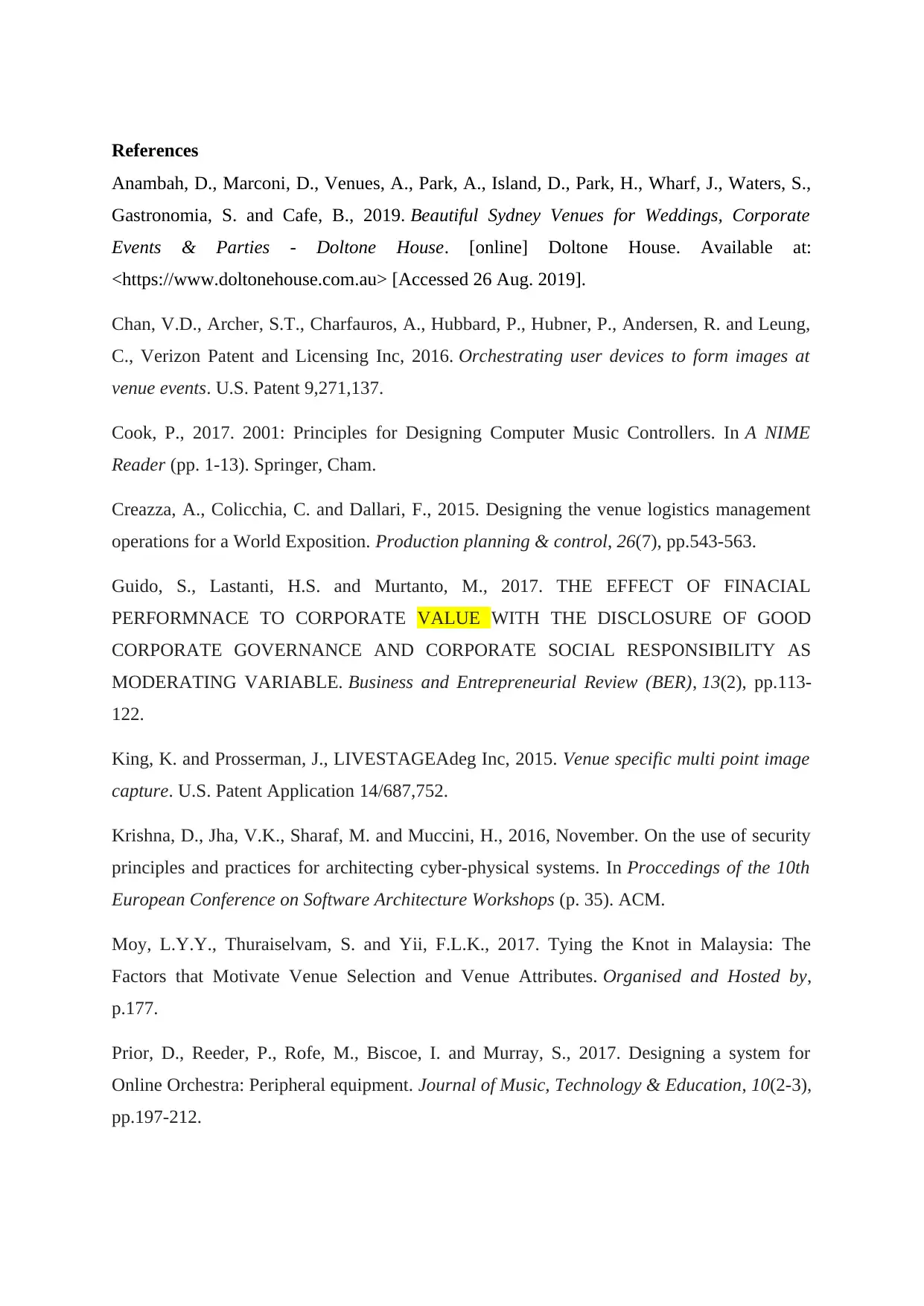
References
Anambah, D., Marconi, D., Venues, A., Park, A., Island, D., Park, H., Wharf, J., Waters, S.,
Gastronomia, S. and Cafe, B., 2019. Beautiful Sydney Venues for Weddings, Corporate
Events & Parties - Doltone House. [online] Doltone House. Available at:
<https://www.doltonehouse.com.au> [Accessed 26 Aug. 2019].
Chan, V.D., Archer, S.T., Charfauros, A., Hubbard, P., Hubner, P., Andersen, R. and Leung,
C., Verizon Patent and Licensing Inc, 2016. Orchestrating user devices to form images at
venue events. U.S. Patent 9,271,137.
Cook, P., 2017. 2001: Principles for Designing Computer Music Controllers. In A NIME
Reader (pp. 1-13). Springer, Cham.
Creazza, A., Colicchia, C. and Dallari, F., 2015. Designing the venue logistics management
operations for a World Exposition. Production planning & control, 26(7), pp.543-563.
Guido, S., Lastanti, H.S. and Murtanto, M., 2017. THE EFFECT OF FINACIAL
PERFORMNACE TO CORPORATE VALUE WITH THE DISCLOSURE OF GOOD
CORPORATE GOVERNANCE AND CORPORATE SOCIAL RESPONSIBILITY AS
MODERATING VARIABLE. Business and Entrepreneurial Review (BER), 13(2), pp.113-
122.
King, K. and Prosserman, J., LIVESTAGEAdeg Inc, 2015. Venue specific multi point image
capture. U.S. Patent Application 14/687,752.
Krishna, D., Jha, V.K., Sharaf, M. and Muccini, H., 2016, November. On the use of security
principles and practices for architecting cyber-physical systems. In Proccedings of the 10th
European Conference on Software Architecture Workshops (p. 35). ACM.
Moy, L.Y.Y., Thuraiselvam, S. and Yii, F.L.K., 2017. Tying the Knot in Malaysia: The
Factors that Motivate Venue Selection and Venue Attributes. Organised and Hosted by,
p.177.
Prior, D., Reeder, P., Rofe, M., Biscoe, I. and Murray, S., 2017. Designing a system for
Online Orchestra: Peripheral equipment. Journal of Music, Technology & Education, 10(2-3),
pp.197-212.
Anambah, D., Marconi, D., Venues, A., Park, A., Island, D., Park, H., Wharf, J., Waters, S.,
Gastronomia, S. and Cafe, B., 2019. Beautiful Sydney Venues for Weddings, Corporate
Events & Parties - Doltone House. [online] Doltone House. Available at:
<https://www.doltonehouse.com.au> [Accessed 26 Aug. 2019].
Chan, V.D., Archer, S.T., Charfauros, A., Hubbard, P., Hubner, P., Andersen, R. and Leung,
C., Verizon Patent and Licensing Inc, 2016. Orchestrating user devices to form images at
venue events. U.S. Patent 9,271,137.
Cook, P., 2017. 2001: Principles for Designing Computer Music Controllers. In A NIME
Reader (pp. 1-13). Springer, Cham.
Creazza, A., Colicchia, C. and Dallari, F., 2015. Designing the venue logistics management
operations for a World Exposition. Production planning & control, 26(7), pp.543-563.
Guido, S., Lastanti, H.S. and Murtanto, M., 2017. THE EFFECT OF FINACIAL
PERFORMNACE TO CORPORATE VALUE WITH THE DISCLOSURE OF GOOD
CORPORATE GOVERNANCE AND CORPORATE SOCIAL RESPONSIBILITY AS
MODERATING VARIABLE. Business and Entrepreneurial Review (BER), 13(2), pp.113-
122.
King, K. and Prosserman, J., LIVESTAGEAdeg Inc, 2015. Venue specific multi point image
capture. U.S. Patent Application 14/687,752.
Krishna, D., Jha, V.K., Sharaf, M. and Muccini, H., 2016, November. On the use of security
principles and practices for architecting cyber-physical systems. In Proccedings of the 10th
European Conference on Software Architecture Workshops (p. 35). ACM.
Moy, L.Y.Y., Thuraiselvam, S. and Yii, F.L.K., 2017. Tying the Knot in Malaysia: The
Factors that Motivate Venue Selection and Venue Attributes. Organised and Hosted by,
p.177.
Prior, D., Reeder, P., Rofe, M., Biscoe, I. and Murray, S., 2017. Designing a system for
Online Orchestra: Peripheral equipment. Journal of Music, Technology & Education, 10(2-3),
pp.197-212.
1 out of 8
Your All-in-One AI-Powered Toolkit for Academic Success.
+13062052269
info@desklib.com
Available 24*7 on WhatsApp / Email
![[object Object]](/_next/static/media/star-bottom.7253800d.svg)
Unlock your academic potential
Copyright © 2020–2025 A2Z Services. All Rights Reserved. Developed and managed by ZUCOL.

